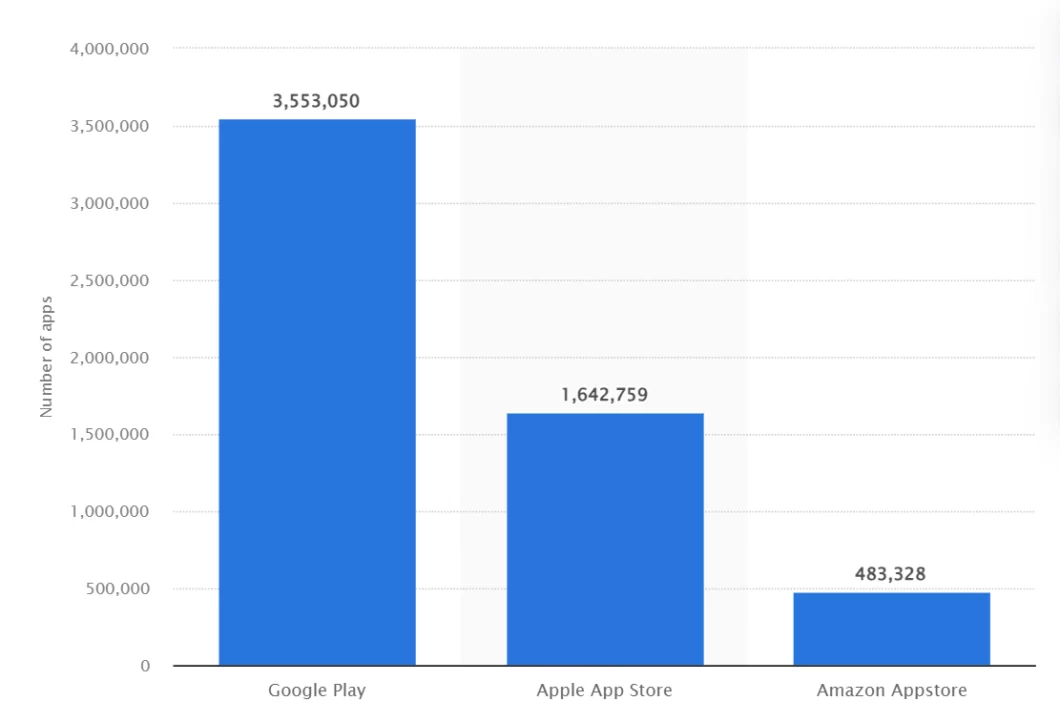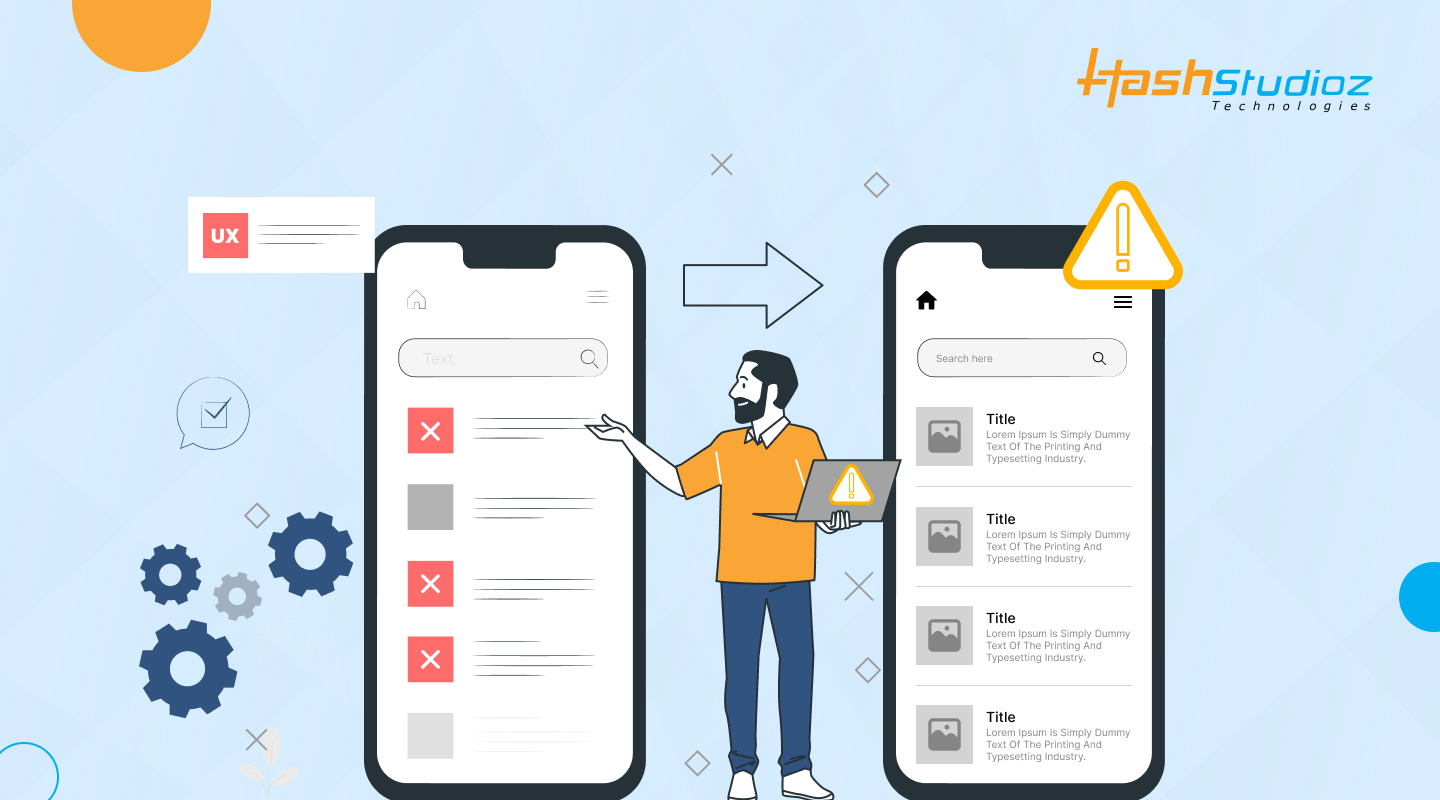Over the past few years, mobile apps have grown exponentially. According to Statista, Android users were able to choose between 3.55 million apps, making Google Play the app store with the biggest number of available apps. The Apple App Store was the second-largest app store with roughly 1.6 million available apps for iOS.

How does a first-time founder create an app that wows users in such a crowded market?
A seamless and intuitive mobile UX is a key factor that sets successful apps apart from the rest.
By 2027, the UX and UI design market will grow by more than 20 percent worldwide. User interface (UI) and user experience (UX) are integral parts of your design and customer experience processes.
In this article, we will discuss the most common UX mistakes that designers and developers make when developing apps.
Table of Contents
UX Mistakes that Designers and Developers Make
Overloaded user interface
How would you feel about developing an app that has many features, each of which is unique?
The idea may seem good from a business perspective. However, the end users should also be considered.
If your app has too many features, it may indicate that you lack clarity about your brand’s strengths.
The experience is similar to visiting a restaurant with almost every type of cuisine on the menu. An overwhelming feeling is more likely to accompany a visitor than excitement.
When a dessert is included as part of a meal, it signifies that it is a component of the meal rather than comprising the entire meal itself.
When your app has too many features from the get-go, your users may wonder what your brand is really about.
Innovation at the Price of Usability
For example, when a user opens an eCommerce website, they expect to see a cart in the upper right-hand corner. These types of websites should follow this universal UX rule.
Changing the general rule for innovation’s sake, however, could confuse end users. It will be a big repulse for a customer to visit an eCommerce website and not see the shopping cart in the upper right corner. This will cause them to abandon the site.
Remember that you cannot implement innovation in the backbone elements, as these elements facilitate fast navigation for users.
Considering UX only at the beginning
UX design is a continuous process. Creating an exceptional mobile experience starts with empathizing, defining, ideating, prototyping, and testing. It is important to note, however, that these stages are not necessarily sequential and often run simultaneously, repeating iteratively.
The stages of design thinking should be viewed as distinct roles that are integral to the design process. At the end of the process, you should be able to understand the purpose and audience of the product.
The whole process sets expectations for the mobile product. Empathy is the key to designing a great mobile experience, which reveals solutions to user pain points that may not be immediately obvious. A rapid prototyping process involves framing and reframing the perceived problem to gain perspective and find as many possible solutions as possible.
Product teams continually review and refine the product concept during prototyping, returning to the beginning several times until a desirable, feasible, and viable concept is achieved.
Confusing apps
Thousands of apps are available on the App Store, but confusing apps don’t attract much attention. Hence, we recommend using tried and tested methods rather than experimenting unless necessary. Design elements that are likely to confuse users should be rigorously tested.
Lack of understanding of users’ needs
Building great products, including mobile apps, starts with understanding your users.
You must understand your audience before you design your app, which will require some research:
- Which features and benefits would be most valuable to our users?
- What are the pain points or problems that our product solves?
- How does our solution differ from the competition?
- For a great mobile experience, what sort of interface is essential?
UX design for mobile apps is an iterative process that may evolve based on customer feedback.
User-Centered Design (UCD) is a framework that founders commonly use. UCD focuses on users and their needs throughout the design process, rather than afterward.
An iterative approach and proper customer research will help you understand who your users are and what they need and then adapt your design accordingly. Creating an experience that resonates with your users is the key to success.
Confusing layouts
It may be difficult for users to continue with the app if the layout is confusing or hard to understand. They’re more likely to give up and look elsewhere when they don’t know how to continue.
Completely imitating competitors
Successful business niches attract a large number of entrepreneurs. That does not mean, however, that successful competitors should be closely monitored.
To build a brand in a specific niche, you must think about making it unique and different from competitors. Without providing something new to your competitors’ targeted customers, you won’t give them any reason to buy your app.
Think twice before copying the way your competitors are building their brands.
Many business owners and even developers make this mistake when designing mobile apps.
Designing for yourself instead of the user
Often, development teams have strong opinions about products. A good UX designer separates his or her personal preferences from the preferences of users. Designing for specific users with specific needs and wants is crucial. Throughout the entire development process, it is crucial to consider users’ needs to prevent the app from evolving solely based on the developers’ preferences.
Confusing UI with UX
Concepts for mobile app design are constantly evolving as technology advances, leading to changes in the way work is described. It’s important to note that UI and UX are distinct but interconnected. One cannot work on a design concept without considering the other.
User experience (UX) design, with its emphasis on careful analysis, plays a pivotal role in ensuring the app’s functionality is seamless and intuitive for users.
Conversely, user interface (UI) design focuses on crafting visually engaging and interactive interfaces. App success relies on effectively utilizing both of these design disciplines in tandem.
Failing to design for mobile devices
As mobile devices become more prevalent, designers must take into account their unique needs and limitations. A poorly designed mobile experience can lead to lost business and a poor user experience. Designers should design mobile-first and test their designs on multiple devices to avoid making this mistake.
Although every mobile app development company strives to build an application, not all of them are successful. UX issues are the most common reason for app uninstalls.
The following are some common errors in mobile user experience design:
- Small buttons that may be difficult to see on a smaller screen.
- On mobile devices, excessive or crowded text can make it difficult to read.
- Poor-quality or low-resolution images that don’t look good on mobile devices.
- Difficult-to-understand navigation can make it difficult for users to find what they are looking for.
HashStudioz Technologies Inc. is a top-notch product design company that provides top-quality UI/UX design services worldwide. UI and UX designers at HashStudioz create compelling designs and are well-versed in all the latest guidelines of the leading app stores.
Conclusion
In conclusion, avoiding common UX design mistakes is crucial for the successful development of mobile apps. By understanding the potential pitfalls and taking proactive measures to address them, app developers can create a seamless and user-friendly experience.
By prioritizing user satisfaction and continuously improving the app’s usability, developers can create mobile apps that truly resonate with users and drive positive engagement.

